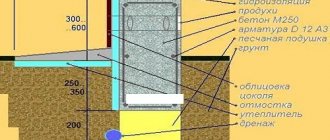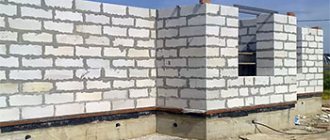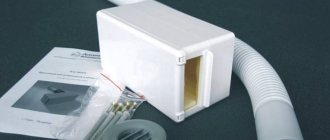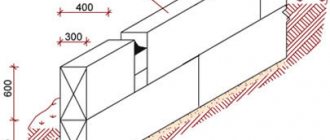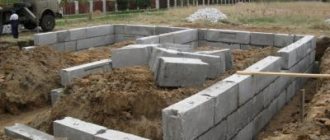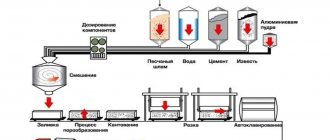In the private sector, artificial stones made from cellular concrete are often chosen for the construction of residential and other structures. And there is a logical explanation for this - good quality combined with reasonable cost. The article offered to the reader is devoted to the technology of building houses from aerated concrete blocks, with an emphasis on performing all operations with your own hands, in stages. Before considering the features of construction, it is necessary to understand some nuances, and first of all, terminology. In everyday life, aerated blocks are a group of stones made from lightweight concrete, the characteristics of which are slightly different. The similarity is only in the names, and this must be taken into account.
Aerated concrete is a cement-based material that acts as a binder. Such blocks can be recognized by their grayish tint. This representative of the class of cellular concrete is often confused with gas silicate. The fundamental difference is not only in the production technology, but also in the fact that when producing this building stone, not cement, but lime is introduced into the initial mixture. Therefore, the color of such blocks is white. Everything that will be discussed below concerns the nuances of building houses from aerated concrete.
Construction of country houses from aerated concrete: practicality and reliability
- Thermal insulation and vapor permeability
Blocks of the D400 and D500 brands provide sufficient strength and thermal insulation to the enclosing structures of residential buildings even with a thickness of 37-40 cm. At the same time, the “breathing” ability of the walls is maintained due to the vapor permeability coefficient of 0.25 mg/(m*h*Pa).
- Ease of production and transportation
Aerated concrete can be produced in an autoclave even directly on the construction site; all that is required is concrete, aluminum suspension and lime. Porous blocks can be quickly delivered by any transport of sufficient capacity and unloaded without special equipment.
Conclusion
In this material, we tried to show the phased construction, indicating the necessary key points to which special attention should be paid. You should have understood that experts consider the best foundation to be a reinforced concrete slab, and the laying solution is glue (see also the article “Service life of concrete: extending the service life of a concrete structure”).
They also talked about reinforcement and the properties of the material to absorb moisture, which must be taken into account when finishing buildings. The video in this article will help you find additional information on this topic.
Stages of building a house made of aerated concrete
- Preparation of the construction site and construction of the foundation, which is recommended to be made as a strip foundation.
- Installation of the first row. It should start from the highest corner of the strip foundation. It is recommended to lay the blocks on cement mortar, which compensates for all the unevenness of the poured foundation.
- How to make a house from aerated concrete so that its walls do not suffer from dampness? To do this, before starting to lay the blocks on the foundation, you should lay roofing felt or other rolled waterproofing.
- Covering the walls. It is practically no different from buildings erected from other materials, but supporting armored belts should be installed under heavy slabs.
- Construction of the roof. Can be of any type, including the attic version. The roofing material for the last stage of building a house made of aerated concrete is selected by the customer according to financial capabilities and taste.
Design
A house made of aerated concrete can be built either according to a ready-made standard project or according to an individual one. Individual design is more expensive, but there is the possibility of maximum consideration of the customer’s requirements and wishes. At the design stage the following must be considered:
- Foundation type;
- Roof type;
- Finish options;
- Planning and zoning of premises;
- Position of the house on the site;
- Estimated cost of construction.
The estimate is prepared by specialists who will take into account all the nuances of certain types of work, calculate the optimal scheme for ordering and delivering material, optimize costs and break down payment into transparent stages. After drawing up the project and estimate, all this is subject to approval. And after receiving permission, you can begin to carry out work.
Material characteristics
The production of aerated concrete is not particularly complex, but requires the use of modern technology to achieve the appropriate quality. The blocks contain quartz sand, lime, aluminum powder and Portland cement. A small percentage of water is also present.
There are two types of aerated concrete depending on the production method:
- autoclaved - made by baking at a very high temperature, which provides increased strength and durability. This explains the difference in cost compared to non-autoclaved aerated concrete;
- non-autoclave - the raw material mixture hardens naturally, after which it is subjected to heat and humidity treatment and pressing under pressure. This type of aerated concrete is less durable, but cheaper than autoclaved.
In both cases, a strong slab is first formed, after which it is cut into blocks of the required size and thickness and sent to air dry.
Advantages of aerated concrete blocks
Aerated concrete was invented more than 80 years ago, and since then has been actively used throughout Europe. It appeared in Russia and Ukraine relatively recently, but construction companies immediately picked up the fashionable trend, and today projects of houses made of aerated concrete blocks can be found in almost every company. What is the reason for such popularity of this material?
First of all, aerated concrete is very light when compared to bricks or concrete slabs. Consequently, transportation costs are reduced and installation is significantly simplified - you don’t have to use large construction equipment if we are talking about low-rise construction.
Aerated concrete is easy to process - it can even be cut with a hand saw. This allows you to speed up the pace of installation without wasting time on adjusting the material. And the performance characteristics of aerated concrete cannot but rejoice - it protects well from the cold, is durable, provides sound insulation, etc.
Advantages of aerated concrete:
- Light weight - aerated concrete block is much lighter than any brick. Its weight can vary from 300 to 1200 kg/cubic meter depending on the dimensions of the product. Ceramic brick weighs at least 1200 kg/cubic meter. In addition to the fact that low weight reduces installation and transportation costs, it also provides less load on the foundation. This means that to build a private house with 1-2 floors, you do not need to spend money on a powerful buried strip or monolithic foundation, but rather create a strong but lighter foundation.
- Easy to Handle – If you've ever had to cut grooves into concrete walls for utility lines, you know that not only is it time-consuming and difficult, but it's also noisy, dusty and tedious. This will not happen with aerated concrete - you can easily drill a hole in it for an socket in a few seconds, manually scrape through the grooves for the wires in one motion, and cut with a handsaw to fit the dimensions.
- High frost resistance - houses made of aerated concrete can be built even in the northern regions of the country. With additional insulation, they will provide a comfortable winter even at low temperatures.
- Fire resistance class A1 - this means that aerated concrete does not burn and does not support combustion. It is not afraid of short-term exposure to heat, which can occur during a domestic fire, but it is still not worth lining fireplace pipes and chimneys with it.
- Environmental friendliness - aerated concrete blocks, as one might guess from their composition, are completely safe for human health, animals and the environment. If you think about it, you can even use destroyed and crumbled gas blocks to fertilize the soil or create high-quality drainage for planting.
- Anti-corrosion - aerated concrete does not rot, mice do not gnaw it, and insects do not like it.
- Easy installation - you can build a house from aerated concrete with your own hands. Detailed instructions are given below.
- High sound insulation - this quality is explained by the same porous structure, which perfectly absorbs extraneous noise. A house made of aerated concrete blocks will always be quiet and comfortable.
- Good thermal insulation - the high thermal insulation qualities of aerated concrete are explained by its porous structure. The presence of tiny voids inside the blocks allows you to create a kind of buffer zone that protects the interior of the house from the cold air outside.
- Aerated concrete can withstand pressure up to B2.5 - this means that load-bearing walls up to 20 m high can be erected from blocks. It follows from this that the material is suitable not only for residential, but also for commercial construction.
- Natural ventilation is another compliment to the porous structure. Small voids allow air to circulate freely, do not prevent excess moisture from evaporating, provide access to fresh air and maintain natural humidity in the room and inside the walls.
- Finishing walls made of aerated concrete is very simple - the material does not need leveling, and any plaster fits perfectly on a rough surface.
Disadvantages of aerated concrete blocks
Unfortunately, humanity has not yet invented a perfect building material that does not have a single drawback. Likewise, aerated concrete has its own vulnerabilities, which can significantly affect the choice.
Disadvantages of aerated concrete:
- Ease of processing also has a second side to the coin - fragility. The strength of aerated concrete is determined by the production method and brand. Thus, blocks that can withstand serious compressive loads usually cannot withstand trivial impacts - if you accidentally hit an aerated concrete wall when installing furniture or driving a nail, it can crack. Also, during installation, you should not throw gas blocks (especially D300 and D400), since they are likely to crack.
- Although transportation of aerated concrete will be cheaper and faster, it will require special conditions. The blocks should be transported only in their original packaging and only on Euro pallets, carefully stacked on top of each other.
- The porous structure is great, but it makes aerated concrete very hygroscopic. When in direct contact with moisture, it actively absorbs it, as a result of which it becomes heavier, loses strength and thermal insulation properties. Having become properly damp, the block inevitably collapses, especially if we are talking about a multi-story building. For example, if a pipe burst in a bathroom on the third floor, then the wall and ceiling in this place will no longer inspire reliability. By the way, for the same reason foundations and basement floors are not built from aerated concrete blocks.
- Since aerated concrete loves to absorb water from any source, you should be careful when choosing finishing materials - it can instantly pick up moisture from the plaster or adhesive mortar.
A house made of aerated concrete blocks with your own hands is possible, but you still need to have some skills. For example, if you have never held a hacksaw or drill in your hands, do not know how to use a building level or plumb line, and do not know how to work with a spatula, then there is no question of any construction.
How to choose aerated concrete blocks
Gas blocks are very different, and they differ not only in quality, but also in shape. The dimensions of aerated concrete blocks for building a house, in turn, determine their purpose - construction, partitioning with a thickness of only 15 cm, in the shape of the letter “U” or equipped with profiled sidewalls with special grooves. The latter, by the way, allow installation without vertical seams, making the wall much stronger.
There are also reinforced reinforced beam blocks that are used to create window and door spans. The thickness of such a block can be as much as 50 cm.
The cost of the blocks differs depending on the brand, so in order to avoid, if not saving, then not spending more than expected, you should choose aerated concrete specifically for your future building. The desire to save money and non-compliance with installation technology will very quickly bear fruit in the form of cracks in the walls and cold bridges during the cold season.
If you already have experience in building from piece materials (brick or stone), then to master aerated concrete you just need to familiarize yourself with its characteristics and review the GOST and SNiP standards.
